Madhya Pradesh Assembly election results will tell us more about 2019 than all other four states, here’s why

Madhya Pradesh has emerged as the most coveted prize to bag among the three north Indian states due to elect their new Assemblies this year. This is because Madhya Pradesh mirrors the big Indian story of agrarian distress, economic disruptions caused by demonetisation and the Goods and Services Tax, and social conflict. Should the Bharatiya Janata Party (BJP) still win the state for the fourth time in a row, the Congress will seem a ship doomed to sink in the whirlpool of the 2019 Lok Sabha elections. Conversely, a Congress victory will have the party set sail its flotilla for capturing power in Delhi.
Among the three north Indian states, Chhattisgarh’s national significance is limited as it sends only 11 MPs to the Lok Sabha. By contrast, Madhya Pradesh has 29 Lok Sabha seats, just three more than Rajasthan’s 26. Yet Rajasthan has been relegated in importance because a Congress triumph here will be par for the course. Ever since the BJP formed the government in Rajasthan in 1993, the power there has alternated between it and the Congress every five years. A Congress victory, therefore, cannot be taken as a reflection of the political mood in north India.
By contrast, the BJP won 165 out 230 Assembly seats in Madhya Pradesh in 2013, 143 in 2008, and 173 in 2003. More significantly, it polled 44.87 percent of votes in 2013, 37.64 percent in 2008, and 42.50 percent in 2003. In fact, in the 2014 Lok Sabha elections, the BJP’s vote share ballooned to a stunning 54.03 percent, a rarity in India.
“In the aftermath of the fall of the Congress nationally, there are not many states where the dominance of one single party has been shaping so clearly. In Madhya Pradesh, the Congress is not only kept out of power, but the BJP has also established its domination beyond electoral politics,” wrote Yatindra Singh Sisodia in Electoral Politics in Madhya Pradesh: Explaining the BJP consolidation, a paper he authored in 2014.
Based on the post-poll survey he conducted for the Centre for the Study of Developing Societies, Delhi, Sisodia, quite significantly, added, “It (BJP) has also been able to spread its support base across social sections… While the leadership (Prime Minister Narendra Modi and Chief Minister Shivraj Singh Chouhan) factor that contributed to the electoral success may have limitations in the long run, the fact that the BJP has wider social base and that it is seen as a party that may perform better than its rivals, will surely remain more dependable factors in this consolidation.”
Shivraj Singh Chouhan and Narendra Modi. AFP file imageShivraj Singh Chouhan and Narendra Modi. AFP file image
Not only has the Congress been kept out of power in Madhya Pradesh for 15 years, it lags far behind the BJP. For instance, it polled 36.38 percent of votes in the 2013 Assembly elections, nearly nine percent less than the BJP. Yet the hopes of the Congress have risen because of the social and economic tumult in the state, making it believe that the moment is propitious to overcome the massive lead the BJP has over it. Only a Congress win or photo finish in Madhya Pradesh will provide proof whether anti-incumbency, of even indeterminate magnitude, has set in against Modi and the BJP.
Yet the task of beating the BJP in Madhya Pradesh is formidable. For instance, agrarian distress in the state has been grabbing headlines, mostly notably when five farmers died in police firing last year. Traditionally, the BJP is considered an urban-centric party. Yet, in 2013, out of 194 constituencies in the state where urban population is less than 50 percent, the BJP won as many as 132, against the 55 that the Congress won. These comparative figures show the BJP has roots deep enough in rural Madhya Pradesh to limit the outfall of the discontent among farmers.
The challenge before the Congress to eat into the BJP’s rural base can also be perceived from the perspective of caste. The largest segment of agriculturists in the state belongs to the Other Backward Classes (OBCs), which account for around 42 percent of the electorate. Chouhan is a Dhakad, an OBC community engaged in agriculture and constituting about 3 to 4 percent of the state’s electorate.
The BJP’s OBC base is formidable – 67 percent of Yadavs voted for it in 2013 as against 25 percent of them for the Congress. The chasm between the two parties was less when it came to the support of non-Yadav OBCs – 45 percent of them voted for the BJP and 35 percent for the Congress. Given that the Dhakads are not numerically preponderant, it can be argued that Chouhan’s OBC identity will not stem the BJP’s slide because of agrarian distress.
However, Chouhan has refrained from harping on his OBC identity, choosing instead to project himself as the “son of a farmer.” He has repeatedly projected the Congress as the party of “raja (Digvijay Singh), maharaja (Jyotiradita Scindia) and udyogpati (industrialist).” In this context, it will be interesting to see whether agrarian distress will drive farmers to desert one of their own fighting to save his chief ministerial chair.
Should the BJP’s support among OBC farmers crack in a state that is its stronghold, it will be to the benefit of Opposition parties anchored among middle castes. In north India, the gains will not accrue to the Congress, whose upper caste leadership structure has always shied away from courting the OBCs on the basis of their caste identity.
As such, in Madhya Pradesh, both the upper castes and OBCs have been railing against the BJP for reversing the Supreme Court judgment that was seen to have diluted the Scheduled Castes and Scheduled Tribes (Prevention of Atrocities) Act.
In 2013, the BJP won 28 out of 35 seats reserved for SCs and 31 out of 47 seats reserved for STs. The anger among the upper castes and OBCs could, quite surprisingly, adversely impact the BJP in the SC reserved seats. This is because in 30 out of 35 such seats, the OBCs and the upper castes together account for as much as 60-65 percent of votes. Should they decide to not support the BJP, its 2013 tally of 28 seats would likely dip.
Comprising less than 16 percent of the electorate, the upper castes have been die-hard supporters of the BJP in Madhya Pradesh – 57 percent of Brahmins, 60 percent of Rajputs and 43 percent of other upper castes voted for the BJP in 2013. In comparison, only 22 percent of Brahmins, 25 percent of Rajputs and 25 percent of other upper castes did for the Congress.
Is the disaffection of the upper castes against the BJP strong enough to propel them in decisive numbers to the Congress? The answer to this question will determine whether the Congress will continue to play the soft Hindu card, such as indulging in its own brand of politics over the cow and projecting its leader Rahul Gandhi as the janeu-dhari Brahmin. Madhya Pradesh could very well have the Congress redefining its self – and becoming a pole to which the upper castes, particularly Brahmins, could decide to flock.
In hindsight, one reason why the Congress did not stitch an alliance with the Bahujan Samaj Party (BSP) was perhaps because it feared such a decision would alienate the upper castes and OBCs-farmers. In 2013, 36 percent of SCs voted for the BJP in 2013, 33 percent for the Congress and 22 percent for the BSP. What the Congress could have gained from aligning with the BSP, it hopes to more than make up with the votes of the upper castes and farmers.
Yet it might become a problem for the Congress if the BSP’s vote-share among Dalits increases exponentially and the upper castes and OBCs don’t desert the BJP in significant numbers. In 2013, out of 57 constituencies having SC population of 20 percent and above, the Congress won just eight seats and the BJP a whopping 46. Then again, out of 80 seats in which STs constituted 20 percent or more of the population, the BJP won 49 seats and the Congress 29.
Much has been written on Madhya Pradesh’s economic woes arising from demonetisation and the Goods and Services Tax. In 2013, the BJP polled 42 percent of votes of the upper income group, 46 percent of the middle income group, 45 percent of the lower income group, and 44 percent of the poor. By contrast, the Congress polled 27 of votes of the upper income group, 34 percent of the middle income group, 38 percent of the lower income group, and 44 percent of the poor.
In other words, the BJP was voted by as many poor as was the Congress, traditionally the principal recipient of their votes. Let alone the poor, in case the BJP loses substantial ground among the middle and lower income groups, the Congress would cite this as proof of the backlash against the Modi government’s economic policies. It could arm the Congress to mount an attack on the BJP before the 2019 Lok Sabha elections.
Creating credible narratives in electoral politics is undoubtedly important. But Madhya Pradesh’s significance goes far beyond that – it will tell us whether the BJP has the skills to resolve the animosities its own social policies have triggered among its large support base; and whether it can pacify those who have been cut by its economic policies. On the other hand, the fall of the BJP’s impregnable fortress of Madhya Pradesh will recast Congress’ personality into a mould that will have an upper caste polish to it, apart from encouraging its leaders into believing that anti-incumbency has started to work against the BJP and that they have hit upon the right strategy to take advantage of it.





